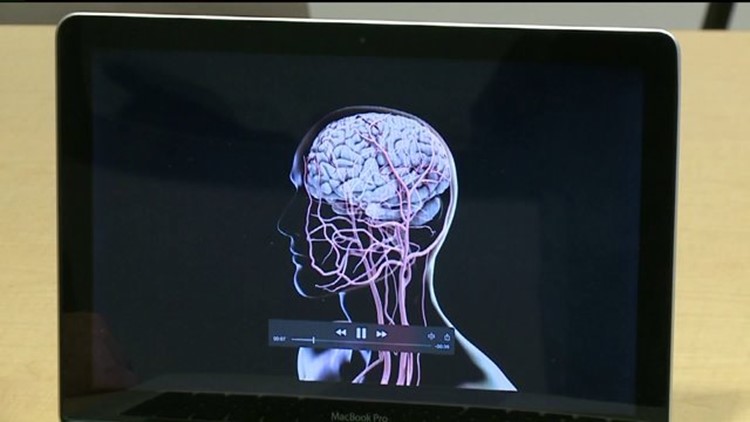According to a Geisinger doctor, one-third of patients who have a ruptured brain aneurysm never make it to a hospital. Of the remaining 2/3 who do, half will be left with some sort of permanent disability. One woman in Lackawanna County beat those odds last year. We spoke with her, and the doctors who performed a relatively new procedure to save her life, for this Healthwatch 16 report.
Joanna Pazzalia from Moscow remembers only a bit about the day in May of 2014 that changed everything for her. The 64-year-old had a horrible headache the night before, but woke up feeling okay. The next night she had quite the scare, thankfully with her husband around.
"He said, what's wrong? And I said, my head. It's gonna burst. And I could see white lights in front of my eyes. Streaks of white lights," she remembers.
Within minutes she was on her way to Geisinger CMC in Scranton, and just minutes after that, on a helicopter on her way to Danville. Getting into that chopper is the last thing she recalls.
"I was gone. I was gone! I don't know where I went but I was not here," she says.
It turns out Joanne had a brain aneurysm that had ruptured. A brain aneurysm is a bulge or balloon in a blood vessel in the brain. Many don't ever rupture and are detected during scans. But if they leak or burst, it can be life-threatening.
"We put that stent across the entry part of where the blood flows inside the aneurysm..." begins Dr. Tarun Bhalla, a neurosurgeon at Geisinger Medical Center. He shows us an animation of the procedure he and his colleague, Dr. Clemens Schirmer, used on Joanne when she arrived early that morning. They inserted a pipeline embolization device into the affected blood vessel through a small incision in the groin area. Over time, the stent heals over and stops the blood from flowing into the aneurysm.
"It's relatively novel and seems to be picking up throughout the country, and we figured it'd be good if people heard about it," Dr. Bhalla says.
Dr. Schirmer points out that the device can't be used on all brain aneurysms, depending on their shape and location, but the pipeline procedure is a much better option for some people than a craniotomy, or a traditional brain surgery.
"There's some other things that come with this, there's follow-up involved, something we need to look at once in a while, but overall it's less invasive and we consider it a step in the direction of a minimally invasive surgery," says Dr. Schirmer.
Joanne was discharged from the hospital eleven days later. And when her husband filled her in on what had happened..
"(It) made me realize how life is, how fragile it is," says Joanne.
Dr. Bhalla and Dr. Schirmer say they've used the pipeline embolization procedure on about 3 dozen patients over the last year and a half. As for Joanne, she plans to retire next year and enjoy the rest of her life.



